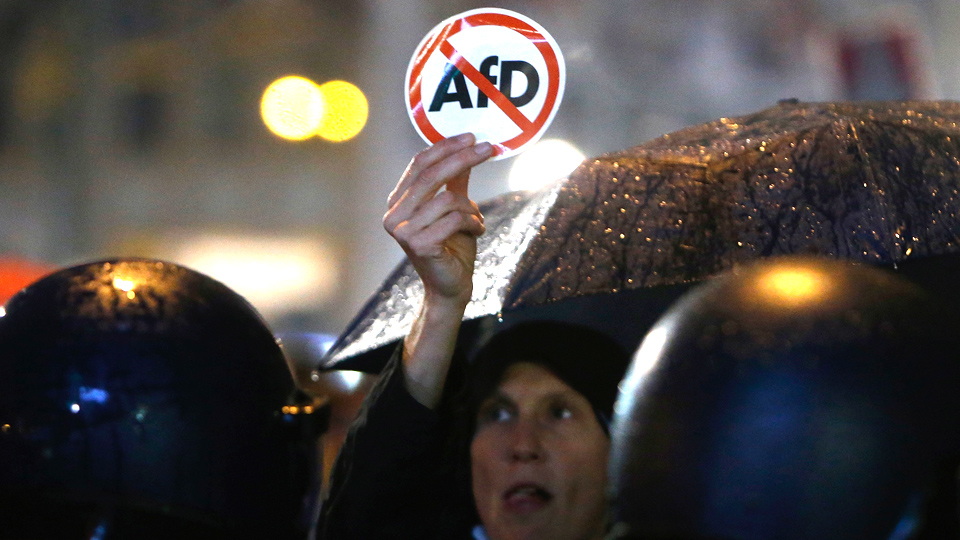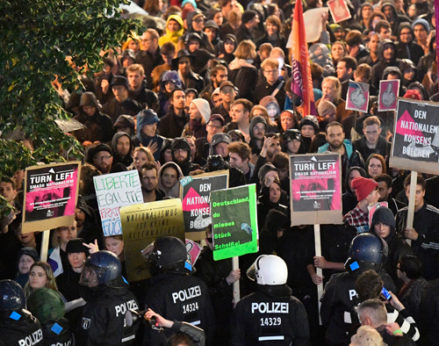
BERLIN — The German election results were shocking only to people not paying attention to what has been happening in this country. A working class and its allies, amounting here as it does in the US to 99 percent of the population, rejected the establishment’s prescription for how to deal with their problems. They rejected austerity, social service cuts, pension cuts, stagnating wages, and government- issued platitudes about how well-off Germany is in comparison to everyone else.
One disaster after another became apparent within minutes of the polls closing Sunday night.
For the chief part of the political establishment, the Christian Democratic Union (CDU), the disaster was the biggest the party has faced since World War II. Polling only a little better than 32 percent, the CDU, led by Chancellor Angela Merkel, was down nine points from its showing in the last election.
The disaster for their junior partner in the government, the Social Democrats (SPD), was also the worst since the end of the war. Support for what was once Germany’s most powerful political party collapsed entirely, with the SPD barely able to get 20 percent of the vote.
The pro-business Free Democratic Party (FDP) came back from oblivion to earn 10 percent of the vote, enough to give them seats in the Bundestag. It should be noted that party leaders emphasized their support for civil liberties during this campaign more than they did their support for no regulations on business, which has dominated their messaging in the past. Four years ago, the FDP had failed to meet the five percent threshold required for any seats in the Bundestag.
The Left Party (Die Linke), despite having no backing whatsoever from any corporate interests, polled 9.2 percent—better than the 8 percent that gave them 64 seats in the Bundestag four years ago.
The Green Party, gaining 8.9 percent of the vote, also did better than in 2013.
As we reported already, the SPD has dropped out of the governing coalition and into the opposition, forcing Merkel to try to cobble together a government with the FDP and the Greens. From the point of view of many Green leaders, this is no disaster, of course. But from the perspective of many of the rank and file Greens, entering a coalition with the pro-business CDU is a disaster.
Seeing how poorly the Social Democrats performed after they spent years propping up Merkel, many Green Party members fear entering a so-called “Jamaica Coalition” with the chancellor could lead voters to associate them with her austerity policies. The “Jamaica Coalition” moniker was coined because the colors of the parties—black for the CDU, yellow for the FDP, and Green for the Greens—mirror the colors of the Jamaican flag.
Nazis in Bundestag
Aside from the CDU and SPD vote hemorrhages, the third big disaster — and probably the biggest of them all — was the entrance of Nazis, at least 79 of them, into the German parliament for the first time since Hitler became chancellor in 1933. This development portends a potential disaster not just for particular political parties, but for Germany itself, Europe, and possibly the world.
The Alternative for Germany (AfD) party, Hitler’s ideological inheritors, polled 12.9 percent of the vote after waging a campaign targeting immigrants and refugees. The party combined its racist rhetoric with a critique of austerity policies that resonated in economically-depressed areas of the country.
The relatively high AfD vote in Saxony (26 percent) for instance, located in what was formerly the German Democratic Republic (GDR), is related to the extremely high unemployment rate there. In many ways, Saxony, Mecklenburg, and a number of other districts in the former East Germany have been treated economically like third world areas over the past quarter-century.
Pension rates and many social security benefits, for example, are far lower in the East than they are in the West. In many formerly-GDR cities, huge hotels that were once trade union-owned resorts for workers are now taken over by wealthy West German businessmen sporting fancy cars and enjoying fun and games in the casinos.
Industrial concerns that hummed away in the socialist days were dismantled after Germany was re-unified in 1990, leaving behind towns with boarded-up shops and youth struggling with drug addiction. Some of the once bustling towns look like former steel mill towns in parts of Pennsylvania.
AfD goes to the people there telling them the causes of their problems are immigrants and “Islamists” who are coddled by the establishment, allegedly taking away the help the “good Germans” need.
Check out more of PW Editor-in-chief John Wojcik’s coverage of the German elections, direct from Berlin:
> Germany’s Die Linke aims to thwart neo-Nazi electoral strategy
> The Left Party offers the real alternative in Germany’s elections
> “Ossies,” former East Germans, compare socialist youth with life under capitalism
> Germany’s Left Party puts money where its mouth is on women’s rights
Anti-fascist unity

With the unfolding of such a changed political situation, a major new opportunity for anti-fascist coalition-building could be opening, however.
If election night was any indication, there is a potential now for broad unity against the AfD. More than 1,000 people descended on the party’s election night celebration in Alexanderplatz immediately after the votes were announced.
AfD leader Alexander Gauland declared inside the Traffic Club, the party’s venue, that “the AfD will push out and crush Merkel and the SPD and Die Linke and the Greens and anyone else who gets in our way!”
As he delivered his threats, protesters outside shouted slogans like “Nie wieder” (“Never again”), “Refugees welcome,” and “All Berlin opposes the AfD.”
The last slogan was no exaggeration because in this city the AfD received its tiniest share of votes anywhere in Germany. Die Linke’s vote in Berlin, which is currently governed by a red-red-green coalition of the SPD, Die Linke, and the Greens, was strong all over the city.
In every district located in what was formerly East Berlin, the capital of the old GDR, Die Linke scored the highest vote totals, beating the CDU, the SPD and everyone else. Even in what was West Berlin, Die Linke raked in vote totals double what they did in the rest of the country.
The demonstrations that broke out in the capital and cities across the country immediately after the election were impressive because of their breadth. In Berlin, there were young people, couples with and without children, LGBTQ couples and singles, Turks who were citizens, and others who were not. There were among the crowd members of the teachers’, social service workers’, and food and commercial workers’ unions. There were Die Linke campaign activists in the crowd too.
With the SPD in the opposition now, it is hoped that a broad movement against the right—including Die Linke, the SPD, the unions, and the anti-fascist groups—can be built. Many of those groups did already come together here already on Remembrance Day last week.
There is no complacency about the fact that the pro-fascist vote was limited to 12.9 percent. Political dynamics can shift rapidly. In 1928, the Nazis got only 2.6 percent of the vote. Two years later, in 1930, they were up to 18.3 percent, and by 1932 pulled in over 30 percent.
The following year, 1933, Hitler became chancellor, and elections ended altogether. Today’s anti-fascists are keeping that fact in mind and are determined to not let down their guard.










